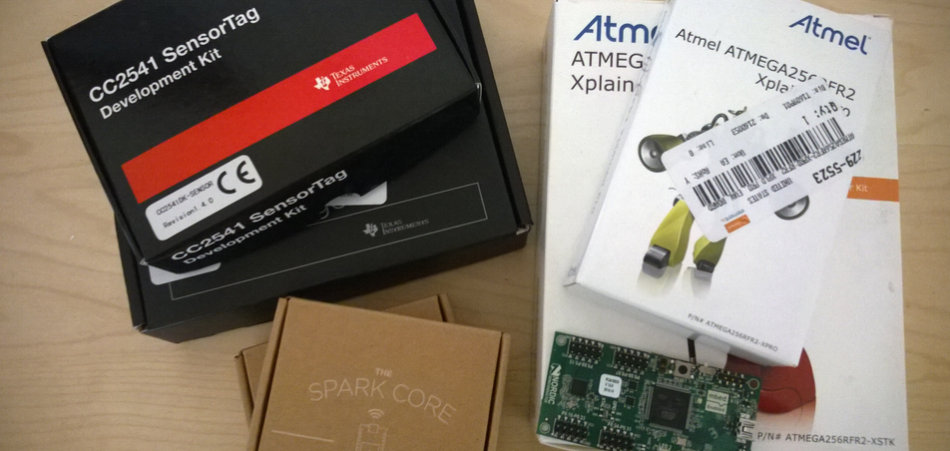
The following entry will cover some of the early research work undertaken in the Sensor Lab at Concordia University. The primary goal of this undertaking is to assess and evaluate IoT hardware and technologies with respect to current consumer products in the market. The assessment will be focus on available low energy wireless transmission protocols and hardware implementations i.e. ZigBee, BLE and Wifi. Majority of the hardware used in the evaluation is available in the Sensor Lab (Spark.io, mBed Nordic BLE and Texas Instruments CC2541 Sensor Tag). Some additional hardware (CC2541 Debugger and Atmel ATMega256RF2 Xplained Kit) was acquired by the Sensor Lab from Newark Element 14. This evaluation of IoT hardware and technologies, along with the hardware from Newark Element 14, allows for a deeper and more comprehensive assessment of the most popular IoT hardware and technologies.
The IoT hardware and the technologies were evaluated on the following requirements: a) ease to create a networked environment, b) ease of sensor integration with hardware, c) ease of actuator integration with hardware, d) Human Interface and Control, e) data transfer rate, e) power consumption and f) cost. It appears that some of the above mentioned technologies are more adept to meeting our requirements i.e. Bluetooth Low Energy – although BLE also has disadvantages.
Additionally, throughout the assessment it was necessary to research and evaluate the ideal data communication protocol that would accompany the IoT hardware. What follows is list of common protocols and a brief description of each.
6LowPAN
The full name is IPv6 over Low Power Wireless Personal Area Networks, and has a primary goal to connect low powered devices to the internet of things. With the optimal conditions and proper devices you can reach up to 200 meters of range and theoretically connect up to a 100 nodes. It operates on the same frequencies as Bluetooth and Wifi which means it is prone to interference – but so are most wireless communication technologies.
Ant and Ant +
Ant is a technology that was geared towards creating a wireless system for sports sensors making it possible to send the data from the sensor to a display unit. It operates in the 2.4ghz spectrum primarily. It is currently in use in the consumer product market and can be compared to BLE. ANT has less extensive conformance procedures than BLE but the ANT+ classification needs a bit more which can be seen as an asset or a downside. The price range is similar to competitors. In the ideal conditions it can reach up to 30m of range and has a very low latency. In fact, according to some, it is one of the best in the latency aspect of wireless transfer(~Zero).
The ANT protocol allows full mesh network topology which is not the case for BLE. This means
a ANT+ device can send to multiple receivers. Multiple transmitting nodes can coexist easily they even say it can go up to hundreds on their website. You can also switch their behaviour from master to slave and relay data transmission. ANT+ is also natively supported on some smart phones, although not omnipresent.
Zigbee 802.15.4
In the price range the Zigbee is fairly accessible. It also has a big community which is always an asset for developers. Zigbee is said to be fairly easy to use in comparisons to other technologies used in the IoT like Bluetooth or WLAN. It operates in the 2.4Ghz frequencies and can cover a
?distance of ~160m, in ideal conditions but in normal conditions it’s about 100m. On the down side, it is considered to be relatively power hungry in contrast to BLE or ANT+. It also appears to have one of the biggest latencies(~20ms). On a more positive note, it fully supports mesh networks and multiple hops. There is no need for a central node with a Zigbee network. It is a standard base technology which means Zigbee equipped devices, even from different manufacturer, should be able to work together.
Dash 7
Dash7 is an open source RFID standard protocol for all sub 1GHz Radio Devices based on the ISO 180007 standard. It operates on 433MHz meaning it is less prone to interference as it doesn’t use the same spectrum as Wifi or BLE. It is assumed to have a very long range and to be best at going through or around concrete water and other environmental obstacles. It is in direct competition with the Zigbee and aims to be cheaper, have a longer range and have low latency. It is also very good on power consumption and fully supports mesh networks and multihop. Since it operates on different frequencies it is good in chaotic conditions like crowds where there can be multiple devices transmitting the same or other frequency therefore creating collision. One of the throw backs is that there is not a big community around the DASH7 alliance yet, making it less accessible than Zigbee for developers. The data rate also seems to be lower.
Bluetooth Low Energy (BLE)
BLE operates on the 2.4Ghz spectrum. It runs on very low power and is native to most smart devicesThis makes BLE very interesting for product designs that aim for a star network where you have a control unit, between a mobile phone and wearable devices. There is a high degree of certifications needed which might bring the costs up. There is also a limit of devices that can be paired together. A Master device can communicate to a maximum of 7 slave devices. It is also very hard to have a slave device communicate to more than one other device. There is a pairing process needed between transmitter and receiver. The range as improved in the past years and in very perfect conditions can reach up to 100m (ideal conditions) with a latency of 2.5 ms. Since its been used in a lot of products and has been embedded in phone for a while there is a large community of developers. It has a high data rate and is considered secured for a fairly low cost.
Wifi
Wifi enabled devices are numerous and the technology has been on the market for a while. It has a pretty large range, about 150m and a latency or ~1.5ms. It operates on the 2.4Ghz spectrum but offers other certifications working on the 5Ghz hence using a dual band.The certification costs are considered to be high, similar to BLE. In the long run it is suppose to be the most complicated technology to embed in a system. However, there has been some great advancement in the past years. It is a good option for the consumer market because most users have used Wifi before and are used to it. It is used in a lot of industries and is considered very secured. One of the issues with Wifi is that it is not very energy efficient. On the other hand it is a fairly robust protocol and has a high data rate. There is a large community of developers working with Wifi and with new products like the Texas Instrument’s CC300, which I will cover later, it is a booming sector. The constant evolution of the Wifi proves that it is a vibrant technology looking to adapt to the needs of the users.
That brings us to the end of the first of several blog posts regarding IoT hardware and technologies. In future posts, a closer look at programming and debugging the Texas Instruments Sensor Tag and the mBed BLE Nordic Board.
